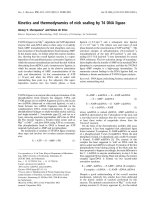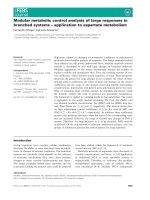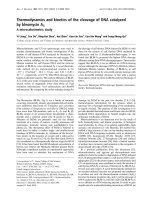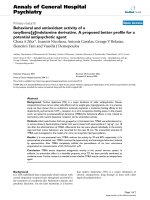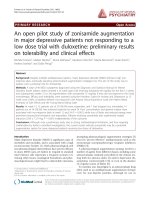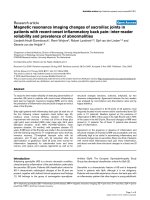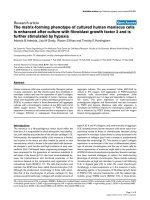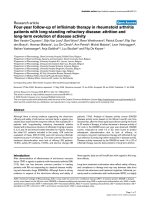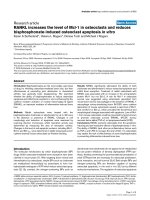Báo cáo y học: "Kinetics and isotype profile of antibody responses in rhesus macaques induced following vaccination with HPV 6, 11, 16 and 18 L1-virus-like particles formulated with or without Merck aluminum adjuvant" ppt
Bạn đang xem bản rút gọn của tài liệu. Xem và tải ngay bản đầy đủ của tài liệu tại đây (389.7 KB, 11 trang )
BioMed Central
Page 1 of 11
(page number not for citation purposes)
Journal of Immune Based Therapies
and Vaccines
Open Access
Original research
Kinetics and isotype profile of antibody responses in rhesus
macaques induced following vaccination with HPV 6, 11, 16 and 18
L1-virus-like particles formulated with or without Merck aluminum
adjuvant
Wanda Ruiz
1
, William L McClements
2
, Kathrin U Jansen
2
and Mark T Esser*
1
Address:
1
Vaccine and Biologics Research Merck Research Laboratories 466 Devon Park Dr. Wayne, PA 19087-8630 USA and
2
Vaccine and
Biologics Research Merck Research Laboratories West Point, PA 19486 USA
Email: Wanda Ruiz - ; William L McClements - ;
Kathrin U Jansen - ; Mark T Esser* -
* Corresponding author
human papillomavirusvaccineneutralizing antibodyLuminex
Abstract
Background: Human papillomaviruses (HPV) are the most common sexually transmitted viruses.
Infection of the cervical epithelium by HPVs can lead to the development of cervical cancer. Recent
advances in vaccine research have shown that immunization with papillomavirus-like particles
(VLPs) containing the major structural viral protein, L1 from HPV 16 can provide protection from
the establishment of a chronic HPV 16 infection and related cervical intraepithelial neoplasia (CIN)
in baseline HPV 16 naïve women.
Methods: To better understand the quantitative and qualitative effects of aluminum adjuvant on
the immunogenic properties of an HPV 6, 11, 16 and 18L1 VLP vaccine, we used an HPV-specific,
antibody isotyping assay and a competitive immunoassay that measures antibodies to neutralizing
epitopes to profile sera from rhesus macaques immunized with the HPV L1 VLP vaccine formulated
with or without aluminum adjuvant.
Results: Immunization with VLPs formulated with the aluminum adjuvant elicited a significantly
stronger immune response with higher peak antibody titers both at four weeks post vaccination
(12.7 to 41.9-fold higher) as well as in the persistent phase at week 52 (4.3 to 26.7-fold higher) than
that of VLPs alone. Furthermore, the aluminum adjuvant formulated HPV VLP vaccine elicited a
predominantly T helper type 2 response, with high levels of IgG1 and IgG4 and low levels of IgG2.
The vaccine also elicited high levels of serum IgA, which may be important in providing mucosal
immunity to impart protection in the anogenital tract.
Conclusion: These results show that the HPV 6, 11, 16 and 18 L1-VLP vaccine formulated with
Merck aluminum adjuvant elicits a robust and durable immune response and holds promise as a
vaccine for preventing cervical cancer.
Published: 20 April 2005
Journal of Immune Based Therapies and Vaccines 2005, 3:2 doi:10.1186/1476-8518-3-2
Received: 03 March 2005
Accepted: 20 April 2005
This article is available from: />© 2005 Ruiz et al; licensee BioMed Central Ltd.
This is an Open Access article distributed under the terms of the Creative Commons Attribution License ( />),
which permits unrestricted use, distribution, and reproduction in any medium, provided the original work is properly cited.
Journal of Immune Based Therapies and Vaccines 2005, 3:2 />Page 2 of 11
(page number not for citation purposes)
Background
Cervical cancer remains a leading cause of cancer-related
deaths in women. HPV infection is the obligate first step
in the development of cervical cancer [1]. Nearly a quarter
of a million women die from cervical cancer and about
half a million are diagnosed with this disease each year
[2]. Cervical cancer accounts for 12% of all cancers in
women and is the second most frequent gynecological
malignancy in the world [3]. A large portion of this health
burden is in the developing world, where women do not
have access to good healthcare and Papanicolaou (Pap)
screens. Although the widespread use of Pap screening in
the developed world has increased the early detection of
cervical dysplasia and cancer, thereby improving treat-
ment outcomes for cervical cancer, it would be far more
preferable to have a vaccine that blocks HPV infection,
thereby preventing initiation of the disease process. Also,
developing countries that usually do not have access to
Pap screening and other preventive measures would fur-
ther benefit from a vaccine that blocks HPV infection and
its subsequent disease consequences. Therefore, there is a
great need for an effective and generally well-tolerated
HPV vaccine, having a low rate of occurrence of adverse
events during administration.
Human papillomaviruses are small double-stranded DNA
viruses. Infection with HPV is the most common viral sex-
ually transmitted diseases worldwide [4]. HPV infects
cutaneous and mucosal epithelial cells and causes benign
and malignant hyperproliferative lesions, which includes
genital warts and cervical cancer [5]. To date, more than
100 HPV types have been identified. Of these, 35 infect
the genital tract [6,7]. Genital HPV types can be divided
into two broad categories: low-risk types which cause gen-
ital warts, cervical dysplasia, but little cancer, and high-
risk types, which cause dysplasia that can progress to can-
cer. HPV type 16 and 18 infection cause 70% of cancer
cases and 25% of low grade cervical dysplasia [8]. HPV
types 6 and 11, on the other hand, cause approximately
95% of genital warts (condylomata acuminata or venereal
warts) and 25% of low grade cervical dysplasia (CIN1)
[9,10]. Thus, a vaccine targeting HPV 6, 11, 16 and 18 will
target the majority of HPV-related clinical disease.
Recently, we reported a proof-of-concept efficacy study for
a prophylactic vaccine composed of HPV 16 L1 virus-like
particles (VLP) formulated on Merck Aluminum Adjuvant
(MAA) [11]. The double-blinded study randomized 2,391
women (16–23 years old) to receive either placebo or
three doses of 40 µg of the HPV 16 VLPs in a 0, 2, and 6
month regimen. The primary efficacy endpoint was per-
sistent HPV 16 infection, including HPV 16 related cervi-
cal dysplasia. Since the vaccine is being developed for
prophylaxis against infection, the primary analysis was
conducted in women who were naïve to HPV 16 at enroll-
ment and remained free of HPV 16 infection through the
completion of the vaccination series. Among placebo
recipients within this cohort, 41 cases of persistent HPV
16 infection were detected. None of the women who
received HPV 16 L1 VLP vaccine in this cohort developed
an endpoint case [11].
Currently, we are investigating a quadrivalent vaccine,
composed of HPV 6, 11, 16, and 18 L1 VLPs formulated
with MAA. This vaccine has also been shown to be effec-
tive in preventing persistent infection and HPV 6, 11, 16
and 18 related cervical dysplasia [12]. To better under-
stand the quantitative and qualitative effects of Merck alu-
minum adjuvant on the immunogenicity of the VLPs we
used a novel HPV type-specific, antibody isotyping assay
and a competitive Luminex immunoassay (cLIA) to meas-
ure HPV type-specific antibody responses in rhesus
macaques. The results presented here show that formula-
tion with Merck aluminum adjuvant increased the VLP's
immunogenicity without affecting the isotype profile.
Methods
Vaccines
Virus-like particles were prepared as previously described
(with modifications) from individual lysates of types- Sac-
charomyces cerevisiae expressing the L1 genes of HPV 6, 11,
16 and 18, respectively [13]. Equal concentrations of all
four HPV VLPs were combined and used either directly, or
adsorbed to MAA. A standard vaccine dose was composed
of 2 µg each of the four VLP types, with or without 225 µg
of MAA. The Merck Aluminum Adjuvant is a proprietary
aluminum hydroxyphosphate sulfate based adjuvant used
in other vaccines manufactured by Merck & Co., [14].
Vaccine study on Rhesus Macaques
Groups of male and female Rhesus macaque (n = 5) were
immunized at weeks 0, 8 and 24 with the two experimen-
tal vaccines described above. Serum was collected at weeks
0, 2, 4, 8, 10, 12, 16, 20, 24, 26, 28 and 52. The animals
were maintained in accordance with the Institutional Ani-
mal Care and Use Committees of Merck Research Labora-
tories (West Point, PA).
Antibodies
The monoclonal antibodies used in the HPV cLIA
included H6.M48 [15] for HPV 6, K11.B2 for HPV 11,
H16.V5 [16] for HPV 16 and H18.J4 [16] for HPV 18.
These antibodies have been shown to be HPV type-spe-
cific and to bind to neutralizing epitopes [17]. The mAbs
were conjugated to phycoerythrin (Chromaprobe, Aptos,
CA) and used at a final concentration of 0.1 µg/mL each.
HPV-specific immunoglobulin isotyping assay
A multiplexed antibody isotyping Luminex assay was
developed to characterize the qualitative aspects of the
Journal of Immune Based Therapies and Vaccines 2005, 3:2 />Page 3 of 11
(page number not for citation purposes)
HPV-specific humoral immune response. The multi-
plexed, isotyping assay was used to classify HPV-specific
antibodies as IgM, IgA, IgE, IgG1, IgG2, IgG4, or total IgG.
IgG3 was not evaluated since rhesus macaques do not
make the IgG3 subclass of antibodies [18,19]. A panel of
isotype-specific monoclonal antibodies to IgE, IgG1,
IgG2, and IgG4 were purchased from either Sigma (St.
Louis, MO) or Southern Biotechnology (Birmingham, AL)
and isotype-specific polyclonal antibodies to IgA, IgM,
and total IgG were purchased from Rockland Inc. (Gil-
bertsville, PA). These antibodies (Table 1) were evaluated
for reactivity to human, rhesus and African green monkey
immunoglobulins. Specificity of the antibodies to their
respective immunoglobulin isotypes was established by a
Luminex assay using purified human IgM, IgA, IgE, IgG1,
IgG2, IgG3 and IgG4 covalently conjugated to Luminex
microspheres. Microspheres were incubated overnight
with Antibody Depleted Human Serum (ADHS), washed
and detected using the isotype specific antibodies at the
concentrations shown in Table 1. Optimum antibody
concentrations, shown in Table 1, were established by
comparing differing concentrations of the detection Abs
in titrations of sera prior to immunization and positive
sera from HPV 6, 11, 16 and 18L1 VLP vaccinated African
green monkeys. Ab concentrations were chosen that gave
the most sensitivity and the greatest signal to noise ratio
between pre-immune and sera from vaccinated animals.
Cross-reactivity between isotype detection antibodies was
examined by conjugating purified human Igs to Luminex
microspheres and incubating these microspheres with
each of the isotyping antibodies at their chosen assay con-
centrations. In these experiments we detected some cross-
reactivity of the anti IgG1 MAb towards IgG2 (71%) and
the anti IgG2 towards IgG1 (58%). This cross-reactivity
was the rationale for decreasing the concentration of the
anti-IgG1 and IgG2 MAbs to 10 µg/mL (Table 1).
For the multiplexed, HPV-specific antibody isotyping
assay, HPV 6, 11, 16, and 18 VLPs were covalently conju-
gated to four distinct Luminex microspheres identified as
microsphere 6, 11, 16 and 18, respectively. Test sera from
vaccinated rhesus macaques were serially diluted 5-fold
starting from a dilution of 1:10 with ADHS and incubated
overnight with the VLPs conjugated to microspheres
(5,000 VLP-microspheres for each type in PBS + 1% Triton
X-100 (PBST) in a total volume of 100 µl in a 1.2 µm
hydrophilic, low protein binding, Durapore
®
membrane
filter plate (Millipore, Bedford, MA). The plate contents
were washed 3 times with 200 µl of PBST and resuspended
in PBST. HPV type-specific antibodies bound to the VLPs
were incubated for 2 hours with biotinylated, isotype-spe-
cific secondary detection antibodies at the concentrations
shown in Table 1. The microspheres were washed three
times, and resuspended in PBST. The biotinylated anti-
bodies were detected by incubation with streptavidin con-
jugated to phycoerythrin (Strep-PE) for 30 min at a final
concentration of 5 µg/mL. The plates were washed 3 times
and read on a Bio-plex analyzer purchased from Bio-Rad
Laboratories, Inc. (Hercules, CA). The Bio-plex analyzer,
based on Luminex xMAP technology, is a modified flow
cytometer that allows for simultaneous quantitation of up
to 100 analytes in a single well and reports Median Fluo-
rescence Intensity (MFI) signals from the Strep-PE detec-
tion reagent [20]. End-point dilution titers were defined
by comparing signals to those of ADHS, the negative con-
trol. For positivity, an MFI value had to be above the
average of ADHS + 10 standard deviations and the end-
point dilution had to demonstrate positivity at the previ-
ous lower dilution.
HPV type-specific competitive Luminex Immunoassay
(cLIA)
An optimized and previously validated HPV competitive
Luminex Immunoassay (cLIA) first described by Opalka et
Table 1: Isotype specific antibodies and streptavidin-PE used in the HPV antibody isotyping assays
Isotype Reagent Type or MAb Identity Specificity Source Supplier Concentration
Primary
IgM polyclonal Monkey IgM (mu chain specific) Goat Rockland, Gilbertsville, PA 50 µg/mL
IgA polyclonal Monkey IgA (alpha chain specific) Goat Rockland, Gilbertsville, PA 25 µg/mL
IgE HP-6029 Human IgE (epsilon chain specific) Mouse Southern Biotech,
Birmingham, AL
25 µg/mL
IgG1 HP-6091or 8c/639 Human IgG1 Mouse Sigma, St. Louis, MO 10 µg/mL
IgG2 HP-6014 Human IgG2 Mouse Sigma, St. Louis, MO 10 µg/mL
IgG4 HP-6025 Human IgG4 Mouse Sigma, St. Louis, MO 25 µg/mL
Total IgG polyclonal Monkey IgG (gamma chain specific) Goat Rockland, Gilbertsville, PA 5 µg/mL
Secondary
PE- Streptavidin NA NA NA Rockland, Gilbertsville, PA 5 µg/mL
Journal of Immune Based Therapies and Vaccines 2005, 3:2 />Page 4 of 11
(page number not for citation purposes)
al. [21] was used to quantify HPV 6, 11, 16, and 18 spe-
cific antibodies to known-neutralizing epitopes on VLPs.
Using the same VLP-conjugated microspheres described
above, antibody titers were determined using a competi-
tive format, where HPV type-specific phycoerythrin (PE)-
labeled monoclonal antibodies (MAbs) to known neu-
tralizing epitopes compete with serum antibodies for
binding to conformationally dependent, neutralizing
epitopes. The fluorescent signals from bound HPV-spe-
cific MAbs are inversely proportional to the subject's neu-
tralizing antibody titers. Relative inhibition of MAb
binding in test serum was compared to a standard refer-
ence serum using a four-parameter logistic curve fit [22].
The reference sera for HPV 6, 11, 16 and 18 used for the
standard curve were assigned arbitrary values expressed in
milli-Merck Units per milliliter (mMU/mL). An antibody
titer of >200 mMU/mL for HPV 11 has been shown to
neutralize ~10
8
virions in the athymic mouse xenograft
assay [23]. The titers for HPV 6 and 11 reference sera were
previously determined in a pseudoneutralization assay
[17]. The lower limit of quantitation for HPV6, 11 and 18
cLIAs is 8 mMU/mL and for HPV 16 is 12 mMU/mL.
Statistical Analysis
Antibody titers obtained from the HPV cLIA were log-
transformed and analyzed using a one-tailed, non-paired,
Student's t-Test. P-values were obtained by comparing the
average log-transformed titers of each of the 5 monkeys
from week 2 to 52 within the two groups. The existence of
a statistically significant difference between antibody tit-
ers from rhesus macaques vaccinated with VLP + MAA ver-
sus VLP alone was shown by a P-value of less than 0.05.
Error bars represent the standard error of log-transformed
titers.
Results
Vaccination with HPV VLPs formulated with aluminum
adjuvant induces significantly higher titers than VLPs alone
The purpose of this study was to characterize the quanti-
tative and qualitative effects of including MAA to the HPV
6, 11, 16 and 18 VLP vaccine. First we wanted to measure
antibody titers to neutralizing epitopes on HPV L1
induced by a quadrivalent vaccine formulated with or
without aluminum adjuvant using the HPV cLIA. Anti-
body titers for all four HPV types in both vaccine groups
developed after the first vaccination, declined, and then
increased again following each boost (Fig. 1). The data are
consistent with a typical prime boost response. Peak anti-
body titers four weeks post dose 3, at week 28, for all four
HPV types were 12.7 to 41.9-fold higher for the group vac-
cinated with VLPs + MAA compared to the group vacci-
nated with VLPs alone, and between 4.3 to 26.7-fold
higher in the persistence phase at week 52 (Table 2A). Stu-
dent's t-Tests of log-transformed antibody titers at week
52 of the VLP + MAA versus the VLP alone group for HPV
6, 11, 16 and 18 also revealed statistically significant P-
values of 0.045, 0.026, 0.039 and 0.008 respectively. Stu-
dent's t-Tests of log-transformed antibody titers from
weeks 2–52 of the VLP+MAA versus the VLP alone group
for HPV 6, 11, 16 and 18 also revealed statistically signif-
icant P-values of 0.0022, 0.0026, 0.0021, and 0.0026
respectively (Fig. 1).
We also wanted to measure the total HPV-specific IgG lev-
els to determine whether the formulation with MAA
increased the total HPV-specific Ab titers. The total HPV-
specific IgG peak titers, and titers seven months post dose
three were consistently higher in the VLP+MAA group
compared to the VLP group alone (Fig. 2). An anamnestic
response was observed after each vaccine boost and total
IgG levels were detectable through one year. The peak
antibody titers four weeks post dose 3, at week 28, in the
VLP+MAA group were between 65.7 to 125.0-fold higher
than those in the VLP alone group throughout the vacci-
nation series and between 18.1 to 90.6-fold higher in the
persistence phase, at week 52 (Table 2B).
HPV-specific antibody isotype responses
To characterize the antibody isotypes elicited by VLPs for-
mulated with MAA or VLPs, alone we modified a multi-
plexed Ab isotyping assay first developed to measure Ab
isotypes in humans [24]. These changes included using
detection mAbs that react with human, rhesus and African
green monkey Igs, where possible (Table 1). In addition
we used biotinylated Abs so that we could use a common
streptavidin-PE detection reagent. This novel HPV-specific
antibody isotyping assay was found to be specific and sen-
sitive for the detection of rhesus macaque IgM, IgA, IgE,
IgG4 and total IgG. Low cross reactivity was seen with the
anti-IgG1 and IgG2 antibodies to purified human IgG2
and IgG1 respectively. Responses to these antibody iso-
types were measured separately for HPV 6, 11, 16 and 18
and were similar to each other. Results for HPV16
responses which are representative of all four types are
shown in figure 3.
We first examined the HPV-specific IgM responses because
IgM antibodies are the first to be produced following vac-
cination and would indicate a primary immune response
to the vaccine. As expected, an IgM response for all four
types was measured after the first immunization at week 0
and is shown for the representative type HPV 16 (Fig. 3A).
Interestingly, two additional primary IgM responses were
observed after each of the booster vaccinations given at
weeks 8 and 24 in both the VLP and VLP+MAA groups of
the study (Fig. 3A). IgM responses in the VLP alone group
returned to baseline by week 52, which was seven months
post dose 3, while an IgM antibody response in the VLP +
MAA group was detectable at week 52.
Journal of Immune Based Therapies and Vaccines 2005, 3:2 />Page 5 of 11
(page number not for citation purposes)
Since HPVs are sexually transmitted viruses that cross the
mucosal barrier in the anogenital tract, we next examined
whether the VLPs induced an IgA response and what effect
formulation with MAA would have on an IgA response. In
theory, the induction of IgA would greatly enhance the
effectiveness of an HPV vaccine. Both vaccine groups dem-
onstrated type-specific IgA responses to the VLPs that were
maintained through one year (Fig. 3B). Each vaccine
boost elicited secondary IgA responses in both vaccina-
tion study groups (Fig. 3B). Higher IgA end-point dilution
titers were observed in the rhesus macaques vaccinated
with VLP + MAA compared to those vaccinated with VLP
alone.
We also examined whether there was an IgE response
induced following vaccination. The geometric mean titers
(GMTs) of IgE responses for the two vaccine groups were
not above background, however one animal in the VLP
group had a detectable IgE response at week 4 for HPV 6
and 16, and at week 24 for HPV 16 (data not shown). This
response was just barely above the limit of detection and
HPV 6, 11, 16 and 18 type-specific antibody titers measured in the competitive Luminex Immunoassay (cLIA)Figure 1
HPV 6, 11, 16 and 18 type-specific antibody titers measured in the competitive Luminex Immunoassay (cLIA).
Sera from rhesus macaques immunized with 2 µg each of HPV 6, 11, 16 and 18L1-VLPs formulated with Merck Aluminum
Adjuvant (MAA) (-◆-) or 2 µg each of HPV 6, 11, 16 and 18L1-VLPs alone (- -) were collected a t the indicated time points
and tested for Abs to neutralizing epitopes on HPV 6, 11, 16 and 18 using the HPV cLIA. Responses are reported as GMTs in
milli-Merck Units per milliliter (mMU/mL) (n = 5 animals per group) for HPV 6, 11, 16 and 18 (Fig 1A, 1B. 1C. and 1D respec-
tively). Arrows indicate vaccination boosts at weeks 8 and 24. A one-tailed, un-paired t-Test analysis was conducted on log-
transformed antibody titers obtained from the cLIA. Error bars represent the standard error of the titers within each group.
HPV 6
1
10
100
1000
10000
100000
0 102030405060
Time (weeks)
GMT (mMU / mL)
VLP (+MAA)
VLP (-MAA)
HPV 11
1
10
100
1000
10000
100000
0 102030405060
Time (weeks)
GMT (mMU / mL)
VLP (+MAA)
VLP (-MAA)
P-value 0.0026
HPV 16
1
10
100
1000
10000
100000
0 102030405060
Time (weeks)
GMT (mMU / mL)
VLP (+MAA)
VLP (-MAA)
P-value 0.0028
HPV 18
1
10
100
1000
10000
100000
0 102030405060
Time (weeks)
GMT (mMU / mL)
VLP (+MAA)
VLP (-MAA)
P-value 0.0026
P-value 0.0022
A.
B.
C. D.
Journal of Immune Based Therapies and Vaccines 2005, 3:2 />Page 6 of 11
(page number not for citation purposes)
was not detected following the booster doses given at
weeks 8 and 24.
We next measured the IgG subtypes to determine whether
formulation with Merck aluminum adjuvant affected the
Ig isotype profile. Characterizing the IgG isotype profile
would also provide insight into whether formulation with
MAA altered the TH1 or TH2 profile of the immune
response. The main IgG subclass observed in both vacci-
nation groups was IgG1 (Fig. 3C). Similar to responses
observed for total IgG, secondary IgG1 responses were
observed after each boost, and titers were maintained
through one year in the VLP + MAA group (Fig. 3C). How-
ever, the group vaccinated with VLP alone had detectable
titers only after the second immunization and these titers
approached baseline values at one year (Fig 3C). We also
observed high levels of IgG4 and Ab titers in the VLP +
MAA group were detected early after each vaccination, but
were undetectable by week 52 (Fig. 3D). The monkeys
vaccinated with VLPs alone only demonstrated IgG4
responses after each vaccination boost, but the titers fell
below the limit of detection soon after (Fig. 3D). We did
not detect a strong IgG2 response in the VLP-alone group
and IgG2 levels in the VLP + MAA group were observed
only immediately following vaccination (data not
shown). However, because we observed some cross-reac-
tivity of the anti-IgG2 MAb to human IgG1, we cannot
rule out the possibility that the IgG2 signals observed were
due to cross-reactivity of the anti-IgG2 MAb to the high
levels of rhesus IgG1 Ab (Fig. 3A). HPV-specific IgG3
responses were not measured because rhesus macaques
do not make the IgG3 subclass of antibodies [18,19]. In
summary, higher total IgG, IgG1, and IgG4 Ab titers were
observed in the rhesus macaques vaccinated with VLP +
MAA compared to those vaccinated with VLPs alone.
Discussion
This is the first study to directly examine the effects of the
Merck aluminum adjuvant on immune responses to a
quadrivalent HPV 6, 11, 16 and 18 L1 vaccine. The results
here were generated using a novel HPV-type specific anti-
body isotyping assay to characterize the immunoglobulin
subclasses to HPV 6, 11, 16 and 18 in rhesus macaques,
and a competitive Luminex immunoassay (cLIA) that
measures HPV-type specific antibodies to known neutral-
izing epitopes. The quadrivalent HPV L1 VLP vaccine for-
mulated with MAA induced higher titers for total IgG (Fig.
2), as well as for all Ig isotypes measured (Fig. 3) com-
pared to the vaccine without MAA. Also the MAA-formu-
lated vaccine induced higher overall antibody titers to
neutralizing epitopes compared to one without MAA (Fig.
1). Strong immune responses were elicited against all four
HPV types and high antibody titers persisted through one
year.
Results from the HPV cLIA showed that the vaccine
induced antibodies that competed with MAbs to known
neutralizing epitopes, and are, thus, theoretically able to
neutralize HPV. It is worth noting that we have previously
shown that a competitive radioimmunoassay (cRIA) [25]
and the cLIA correlate well with an HPV 11 neutralization
assay. Antibody titers in the cLIA also followed a "prime-
boost" response wherein antibody titers were higher after
every vaccine dose. Furthermore, cLIA titers show that for-
mulation of the vaccine with MAA significantly increased
peak neutralizing titers, and, more importantly, the
differences in the responses were durable, persisting
through one year.
Previously, we reported that the Merck HPV 16 L1 VLP
vaccine induced a predominantly TH2 immune response
with IL-4-producing T-helper cells, high levels of neutral-
izing Abs and low levels of IFN-γ secreting CD8
+
or CD4
+
Table 2: Fold difference in geometric mean titers of VLP+MAA-immunized group over VLP alone-immunized group.
A. HPV cLIA time (weeks)
HPV type 0 2 4 8 10 12 16 20 24 26 28 52
HPV 6 1.1 3.2 2.4 4.3 10.0 12.6 36.3 10.9 6.3 22.7 41.9 4.3
HPV 11 0.8 2.9 2.2 5.5 23.5 18.1 16.2 8.2 6.1 18.4 36.8 5.3
HPV 16 1.0 5.2 8.8 8.4 21.4 15.7 16.1 11.4 17.7 4.8 12.7 6.4
HPV 18 1.0 4.8 13.7 19.4 70.5 18.6 27.1 35.4 26.3 6.7 26.8 26.7
B. HPV Total IgG antibodies time (weeks)
HPV type 0 2 4 8 10 12 16 20 24 26 28 52
HPV 6 1.9 9.5 9.5 13.1 125.0 328.3 125.0 65.7 34.4 34.5 65.7 18.1
HPV 11 1.9 13.1 25.0 25.0 125.0 90.6 125.0 47.6 34.5 34.5 90.6 18.1
HPV 16 0.9 5.0 9.5 6.9 65.7 65.7 90.6 65.7 13.1 13.1 65.7 25.0
HPV 18 0.7 9.5 13.1 25.0 125.0 47.6 65.7 65.7 25.0 47.6 125.0 90.6
Journal of Immune Based Therapies and Vaccines 2005, 3:2 />Page 7 of 11
(page number not for citation purposes)
cells [26]. Given that the HPV quadrivalent vaccine also
contains the L1 capsid proteins, the response was also
expected to be TH2-like [27]. Using the HPV isotyping
assay, which is a direct binding assay detecting antibodies
to conserved epitopes shared across multiple HPV types,
we showed that the isotype profile of the vaccinated rhe-
sus macaques was consistent with a TH2-like immune
response. Interestingly, the formulation with MAA did not
affect the overall isotype profile of the vaccinated
monkeys.
Predictably, abundant amounts of IgG antibody isotype
were found, and of all the IgG subclasses, IgG1 was most
readily detected. The abundant presence of IgG1 elicited
in both vaccination groups affirms that the vaccines did
induce immune responses through a TH2 pathway. It is
also interesting to note that the next abundant IgG sub-
class detected, primarily detected in the VLP+MAA group,
was IgG4 (Fig. 3D). IgG4 is more characteristic of a TH1
response and, by inducing this IgG subclass, the vaccine is
shown to be also effective in eliciting a cellular (TH1)
immune response, albeit, predictably not long lasting. It is
HPV 6, 11, 16 and 18 L1 VLP-specific total IgG antibody titersFigure 2
HPV 6, 11, 16 and 18 L1 VLP-specific total IgG antibody titers. Sera from rhesus macaques immunized at week 0, 8
and 24 with 2 µg each of HPV 6, 11, 16 and 18L1-VLP formulated with Merck Aluminum Adjuvant (+MAA) (-◆-) or 2 µg each
of HPV 6, 11, 16 and 18L1-VLPs alone (-MAA) (- -) were collected at the indicated time points and tested for HPV 6, 11, 16
and 18 L1 VLP specific total IgG (-◆-, - -) titers in a multiplexed detection assay. Responses are reported as the geometric
means of end point dilution titers (n = 5 animals per group) for HPV 6, 11, 16 and 18 (2A, B, C, and D respectively). Arrows
indicate vaccination boosts at weeks 8 and 24. The starting dilution for each sample was 1:10 and responses above an end point
dilution of 10 were considered positive.
HPV 6
1
10
100
1000
10000
100000
1000000
10000000
0 102030405060
Time (weeks)
GMT
Total IgG (+MAA)
Total IgG (-MAA)
HPV 11
1
10
100
1000
10000
100000
1000000
10000000
0 102030405060
Time (weeks)
GMT
Total IgG (+MAA)
Total IgG (-MAA)
HPV 16
1
10
100
1000
10000
100000
1000000
10000000
0 102030405060
Time (weeks)
GMT
Total IgG (+MAA)
Total IgG (-MAA)
HPV 18
1
10
100
1000
10000
100000
1000000
10000000
0 102030405060
Time (weeks)
GMT
Total IgG (+MAA)
Total IgG (-MAA)
A.
B.
C. D.
Journal of Immune Based Therapies and Vaccines 2005, 3:2 />Page 8 of 11
(page number not for citation purposes)
worth noting that we previously observed low levels of
IFN-γ secreting CD8
+
and CD4
+
T-cells [26], suggesting the
vaccine induces a low level cellular immune response.
Similar to what we observed in rhesus macaques, isotype
analysis of sera from women vaccinated with the HPV 11
VLP vaccine formulated with MAA also detected little to
no levels of IgG2 [24]. Isotype analysis performed on an
epidemiological study by Wang et al. also found no IgG2
antibody, which they attributed to the unfavorable
cytokine profile of HPV infection for the induction of
IgG2 [28]. Detection of the IgG3 subclass was not per-
formed, because rhesus macaques do not make IgG3
[18,19].
We also measured high levels of serum IgA observed in
vaccinated animals. IgA, the secretory immunoglobulin, is
thought to be very important in blocking viral entry into
mucosal tissues [29]. These findings are consistent with
HPV L1-VLP specific IgM, IgA, IgG1 and IgG4 antibody titersFigure 3
HPV L1-VLP specific IgM, IgA, IgG1 and IgG4 antibody titers. Sera from rhesus macaques immunized at week 0, 8 and
24 with 2 µg each of HPV 6, 11, 16 and 18 L1-VLPs formulated with Merck Aluminum Adjuvant (+MAA) (-◆-) or 2 µg each of
HPV 6, 11, 16 and 18L1-VLPs alone (-MAA) (- -) were collected at the indicated time points and tested for HPV L1 VLP spe-
cific (A) IgM, (B) IgA, (C) IgG1 and (D) IgG4 titers in a multiplexed detection assay. Responses are reported as GMTs (n = 5
monkeys per group) for HPV 16. Arrows indicate vaccination boosts at weeks 8 and 24. The starting dilution for each sample
was 1:10 and responses above an end point dilution of 10 were considered above background. Graphs shown are for HPV 16
and are representative of HPV 6, 11, and 18.
IgG1
1
10
100
1000
10000
100000
1000000
0 102030405060
Time (weeks)
GMT
IgG1
(+MAA)
IgG1
(-MAA)
IgG4
1
10
100
1000
10000
100000
1000000
0 102030405060
Time (weeks)
GMT
IgG4
(+MAA)
IgG4
(-MAA)
IgA
1
10
100
1000
10000
100000
1000000
0 102030405060
Time (weeks)
GMT
IgA
(+MAA)
IgA
(-MAA)
IgM
1
10
100
1000
10000
100000
1000000
0 102030405060
Time (weeks)
GMT
IgM
(+MAA)
IgM
(-MAA)
A.
B.
C. D.
Journal of Immune Based Therapies and Vaccines 2005, 3:2 />Page 9 of 11
(page number not for citation purposes)
what we have observe in the sera from women vaccinated
with the HPV 11 VLP vaccine [24]. The elicitation of IgA
should be advantageous for a vaccine that prevents HPV
infection in defending against entry of HPV, which com-
monly enters through the urogenital tract. The high levels
of IgA elicited by the vaccine may also be one reason why
the vaccine has been efficacious in human clinical trials
[11]. IgE responses were measured because IgE antibodies
are implicated in allergic symptoms. Consistent IgE anti-
body responses were not observed in either group. Only
one animal in the VLP alone vaccine group had detectable
IgE, but the response was barely above the limit of detec-
tion and transient as it was not detected following the
booster immunizations. This is consistent with the obser-
vation of no allergic reactions or severe adverse events in
the monkeys following vaccination. These observations
are consistent with our clinical findings that a VLP + MAA
vaccine was safe and well-tolerated [30]. In summary, the
isotype analysis data are consistent with the VLP+MAA
vaccine inducing primarily a TH2-like immune response
with high titers of IgA and IgG1 antibodies.
In these isotyping studies, we used polyclonal goat anti-
monkey IgM, IgA, and total IgG; because monkey-specific
reagents are not available for the IgG subtypes and IgE, we
used anti-human mouse MAbs to measure IgG1, IgG2,
IgG4, and IgE responses. The polyclonal anti-IgA, IgM and
total IgG reagents were selected for their specificity and
their ability to broadly detect African Green monkey, rhe-
sus macaque and human antibody isotypes. The various
differences between human, rhesus macaque and African
green monkey sera could account for changes in the sensi-
tivity and specificity of the antibody-isotyping reagents
and so the appropriate antibody reagent concentrations
used in the HPV type-specific antibody isotyping assay
were optimized for use with rhesus macaque serum.
Due to the unavailability of purified rhesus Igs, we used
purified human Igs to determine the specificities of the
type-specific antibody isotyping reagents. There was some
observed reactivity of the anti- human IgG2 antibody to
purified human IgG1, and vice versa, but these data were
obtained using purified human Igs and the differences
between human and rhesus antibodies may account for
why we saw a strong IgG1 response with low IgG2 titers
(Fig. 3). However, because we cannot rule out that the
IgG2 titers were merely a reflection of the cross-reactivity
to the high IgG1 titers, we cannot definitively say that
there were any IgG2 responses observed.
In some cases, the test animals had low Ab titers to the
VLPs prior to vaccination. This was not unexpected since
more than 100 papillomaviruses have been identified
[31] and many of these share conserved structural
epitopes that would cross react in a direct binding assay.
For this reason, we used Antibody Depleted Human
Serum (ADHS) as a negative control rather than sera from
rhesus macaques prior to vaccination.
Currently, the only FDA approved adjuvants for use with
prophylactic vaccines are aluminum based [32]. The pur-
pose of this study was to evaluate the effect of the Merck
Aluminum Adjuvant on the immunogenicity of the HPV
L1 VLP 6, 11, 16 and 18 vaccine and our results show that
the addition of the MAA significantly increases the immu-
nogenicity of the vaccine. In sharp contrast to our results,
Harro et al. have reported that formulation with adjuvant
did not significantly enhance the immunogenicity of an
HPV VLP vaccine [33]. In that study, 72 human volunteers
were randomized to receive placebo or an HPV 16 L1 VLP
vaccine produced in insect cells. Vaccine recipients were
given a dose of 10 µg or 50 µg of VLPs formulated without
adjuvant, with an aluminum adjuvant, or with MF59
adjuvant. Since no significant differences in neutralizing
antibody titers and ELISA titers were found in subjects in
all three groups, the authors concluded adjuvant was not
required. Our results were obtained using the quadriva-
lent Merck HPV-L1 VLP vaccine, which is formulated with
Merck aluminum adjuvant. While the mechanisms by
which aluminum adjuvants enhance immunogenicity are
poorly understood, they may act to form an antigen
depot, allowing the vaccine to linger at the site of admin-
istration and perhaps, more importantly, stimulate the
immune system by inducing higher neutralizing Ab titers
[34]. The inclusion of MAA to the vaccine did not induce
a qualitatively different humoral immune response in that
the isotype profile was similar between animals vacci-
nated with the two quadrivalent vaccines (Fig. 3). How-
ever, data from both the antibody isotyping assays and the
cLIA showed that the inclusion of MAA to the VLP vaccine
induced significantly higher Ab titers (Fig. 1, 2, 3). These
data clearly show a benefit to the formulation of the quad-
rivalent HPV-L1 VLPs with MAA.
The differences observed in the immune responses elic-
ited by the vaccine reported by Harro et al. and the Merck
quadrivalent HPV vaccine may be attributed to several fac-
tors. First, would be the differences in the formulation and
purification processes of the vaccines. The vaccine
reported by Harro et al. was produced in insect cells as
opposed to yeast for the Merck vaccine. Second, the differ-
ences in vaccine recipients, humans and rhesus macaques
may respond differently to adjuvanted HPV VLP vaccines.
Lastly, differences in formulation and composition of the
two aluminum adjuvants used could have profound
impacts on immunogenicity. Different aluminum salt
adjuvants were used in these two studies; our study
adsorbed VLPs to a proprietary formulation of aluminum
hydroxyphosphate sulfate (MAA), while the Harro et al.
study used aluminum potassium sulfate. Without a head
Journal of Immune Based Therapies and Vaccines 2005, 3:2 />Page 10 of 11
(page number not for citation purposes)
to head comparison of the two vaccines, it is difficult to
establish why the results are different. However, the mag-
nitude and durability of antibody responses found in the
quadrivalent VLP+MAA vaccinated rhesus macaques
reported in this study are consistent with those found in
human clinical trials of the HPV 11 or HPV 16 monova-
lent vaccines [30].
The isotyping and cLIA assays described in this study are
useful in characterizing the immune responses to HPV vir-
ions after natural infection or following vaccination. The
novel cLIA utilized in this study is a robust and sensitive
method for detecting HPV-specific antibodies in sera to
known neutralizing epitopes on HPV virions and has
proven to be a valuable tool for monitoring HPV immune
responses in human clinical trials of an HPV 6, 11, 16 and
18L1-VLP vaccine. These assays have potential use in
future epidemiology studies and other vaccine clinical
trials.
Conclusion
The results presented here show that an HPV 6, 11, 16 and
18 L1-VLP vaccine formulated with Merck aluminum
adjuvant has increased immunogenicity without affecting
the isotype profile. The VLPs formulated with Merck alu-
minum adjuvant elicited a robust and durable immune
response that lasted up to 52 weeks. This vaccine holds
promise as a vaccine for preventing cervical cancer.
List of abbreviations
MAb, monoclonal antibody; PBS, phosphate-buffered
saline; cLIA, competitive Luminex immunoassay; ADHS,
antibody depleted human serum; VLP, virus-like particles;
HPV, human papillomavirus; GMT, geometric mean tit-
ers; Ig, immunoglobulin; Ab, antibody.
Competing interests
W. Ruiz, W. McClements, K. Jansen and M. Esser were all
employees of Merck Research Laboratories, a division of
Merck & Co., Inc. when this study was performed and
potentially own stock and/or hold stock options in the
Company. Merck is developing a quadrivalent HPV vac-
cine. Merck also funded this study in its entirety.
Authors' contributions
W. McClements and K. Jansen designed the immuniza-
tion study. M. Esser and W. Ruiz developed the
competitive Luminex immunoassay and the new isotyp-
ing assays. W. Ruiz performed all the laboratory assays. W.
Ruiz and M. Esser wrote the manuscript and all authors
read and approved the final manuscript.
Acknowledgements
We would like to acknowledge R. Skibbens and M. Kuchka (Lehigh Univer-
sity, Bethlehem, PA); L. Kierstead, A. Finnefrock, J. Drummond, N. Chir-
mule, E. Shaw, S. Schlottman, G. Wang, J. F. Smith, G. Page, the HPV and
HIV groups (Merck, MRL), for their assistance and support; R. Charbon-
neau and S. Macmullen for previous isotyping development, P. Boerckel for
her expert laboratory assistance, T. Green, for expert statistical advice and
assistance, R. Marchese (Merck MRL Wayne), for her critical reading of the
manuscript and expert guidance, and T. Fujiwara for his continued motiva-
tion and encouragement.
References
1. Walboomers JM, Jacobs MV, Manos MM, Bosch FX, Kummer JA, Shah
KV, Snijders PJ, Peto J, Meijer CJ, Munoz N: Human papillomavirus
is a necessary cause of invasive cervical cancer worldwide. J
Pathol 1999, 189:12-19.
2. Eiben GL, da Silva DM, Fausch SC, Le Poole IC, Nishimura MI, Kast
WM: Cervical cancer vaccines: recent advances in HPV
research. Viral Immunol 2003, 16:111-121.
3. Pisani P, Bray F, Parkin DM: Estimates of the world-wide preva-
lence of cancer for 25 sites in the adult population. Int J Cancer
2002, 97:72-81.
4. Laukkanen P, Koskela P, Pukkala E, Dillner J, Laara E, Knekt P,
Lehtinen M: Time trends in incidence and prevalence of
human papillomavirus type 6, 11 and 16 infections in Finland.
J Gen Virol 2003, 84:2105-2109.
5. zur Hausen H: Viruses in human cancers. Science 1991,
254:1167-1173.
6. Human papillomavirus testing for triage of women with
cytologic evidence of low-grade squamous intraepithelial
lesions: baseline data from a randomized trial. The Atypical
Squamous Cells of Undetermined Significance/Low-Grade
Squamous Intraepithelial Lesions Triage Study (ALTS)
Group. J Natl Cancer Inst 2000, 92:397-402.
7. Bosch FX, Manos MM, Munoz N, Sherman M, Jansen AM, Peto J,
Schiffman MH, Moreno V, Kurman R, Shah KV: Prevalence of
human papillomavirus in cervical cancer: a worldwide per-
spective. International biological study on cervical cancer
(IBSCC) Study Group. J Natl Cancer Inst 1995, 87:796-802.
8. Schiffman MH, Bauer HM, Hoover RN, Glass AG, Cadell DM, Rush
BB, Scott DR, Sherman ME, Kurman RJ, Wacholder S, et al.: Epide-
miologic evidence showing that human papillomavirus infec-
tion causes most cervical intraepithelial neoplasia. J Natl
Cancer Inst 1993, 85:958-964.
9. Greer CE, Wheeler CM, Ladner MB, Beutner K, Coyne MY, Liang H,
Langenberg A, Yen TS, Ralston R: Human papillomavirus (HPV)
type distribution and serological response to HPV type 6
virus-like particles in patients with genital warts. J Clin Microbiol
1995, 33:2058-2063.
10. Brown DR, Schroeder JM, Bryan JT, Stoler MH, Fife KH: Detection
of multiple human papillomavirus types in Condylomata
acuminata lesions from otherwise healthy and immunosup-
pressed patients. J Clin Microbiol 1999, 37:3316-3322.
11. Koutsky LA, Ault KA, Wheeler CM, Brown DR, Barr E, Alvarez FB,
Chiacchierini LM, Jansen KU: A controlled trial of a human pap-
illomavirus type 16 vaccine. N Engl J Med 2002, 347:1645-1651.
12. Villa LL, Costa RLR, Petta CA, Andrade RP, Ault KA, Giuliano AR,
Wheeler CM, Koutsky LA, Malm C, Lehtinen M, Skjeldestad FE, Ols-
son SE, Steinwall M, Brown DR, Kurman RJ, Ronnett BM, Stoler MH,
Ferenczy A, Harper DM, Tamms GM, Yu J, Lupinacci L, Railkar R, Tad-
deo FJ, Jansen KU, Esser MT, Sings HL, Saah AJ, Barr E: A Rand-
omized, Double-blind, Placebo-controlled Efficacy Trial of a
Prophylactic Quadrivalent Human Papillomavirus (Types 6/
11/16/18) L1 Virus-Like Particle Vaccine in Young Women.
Lancet Oncology 2005 in press.
13. Cook JC, Joyce JG, George HA, Schultz LD, Hurni WM, Jansen KU,
Hepler RW, Ip C, Lowe RS, Keller PM, Lehman ED: Purification of
virus-like particles of recombinant human papillomavirus
type 11 major capsid protein L1 from Saccharomyces
cerevisiae. Protein Expr Purif 1999, 17:477-484.
14. Baylor NW, Egan W, Richman P: Aluminum salts in vaccines US
perspective. Vaccine 2002, 20 Suppl 3:S18-23.
15. Christensen ND, Reed CA, Cladel NM, Hall K, Leiserowitz GS: Mon-
oclonal antibodies to HPV-6 L1 virus-like particles identify
conformational and linear neutralizing epitopes on HPV-11
in addition to type-specific epitopes on HPV-6. Virology 1996,
224:477-486.
Publish with BioMed Central and every
scientist can read your work free of charge
"BioMed Central will be the most significant development for
disseminating the results of biomedical research in our lifetime."
Sir Paul Nurse, Cancer Research UK
Your research papers will be:
available free of charge to the entire biomedical community
peer reviewed and published immediately upon acceptance
cited in PubMed and archived on PubMed Central
yours — you keep the copyright
Submit your manuscript here:
/>BioMedcentral
Journal of Immune Based Therapies and Vaccines 2005, 3:2 />Page 11 of 11
(page number not for citation purposes)
16. Christensen ND, Dillner J, Eklund C, Carter JJ, Wipf GC, Reed CA,
Cladel NM, Galloway DA: Surface conformational and linear
epitopes on HPV-16 and HPV-18 L1 virus-like particles as
defined by monoclonal antibodies. Virology 1996, 223:174-184.
17. Yeager MD, Aste-Amezaga M, Brown DR, Martin MM, Shah MJ, Cook
JC, Christensen ND, Ackerson C, Lowe RS, Smith JF, Keller P, Jansen
KU: Neutralization of human papillomavirus (HPV) pseudo-
virions: a novel and efficient approach to detect and charac-
terize HPV neutralizing antibodies. Virology 2000, 278:570-577.
18. Martin LN: Chromatographic fractionation of rhesus monkey
(Macaca mulatta) IgG subclasses using deae cellulose and
protein A-sepharose. J Immunol Methods 1982, 50:319-329.
19. Calvas P, Apoil P, Fortenfant F, Roubinet F, Andris J, Capra D,
Blancher A: Characterization of the three immunoglobulin G
subclasses of macaques. Scand J Immunol 1999, 49:595-610.
20. Fulton RJ, McDade RL, Smith PL, Kienker LJ, Kettman JRJ: Advanced
multiplexed analysis with the FlowMetrix system. Clin Chem
1997, 43:1749-1756.
21. Opalka D, Lachman CE, MacMullen SA, Jansen KU, Smith JF, Chirmule
N, Esser MT: Simultaneous quantitation of antibodies to neu-
tralizing epitopes on virus-like particles for human papillo-
mavirus types 6, 11, 16, and 18 by a multiplexed Luminex
assay. Clin Diagn Lab Immunol 2003, 10:108-115.
22. O'Connell MA, Belanger BA, Haaland PD: The four parameter
logistic model for calibration and assay development. Ameri-
can Statistical Association Proceedings of the Biopharm Section
1992:180-185.
23. Bryan JT, Jansen KU, Lowe RS, Fife KH, McClowry T, Glass D, Brown
DR: Human papillomavirus type 11 neutralization in the ath-
ymic mouse xenograft system: correlation with virus-like
particle IgG concentration. J Med Virol 1997, 53:185-188.
24. Emeny RT, Wheeler CM, Jansen KU, Hunt WC, Fu TM, Smith JF, Mac-
Mullen S, Esser MT, Paliard X: Priming of human papillomavirus
type 11-specific humoral and cellular immune responses in
college-aged women with a virus-like particle vaccine. J Virol
2002, 76:7832-7842.
25. Brown DR, Bryan JT, Schroeder JM, Robinson TS, Fife KH, Wheeler
CM, Barr E, Smith PR, Chiacchierini L, DiCello A, Jansen KU: Neu-
tralization of human papillomavirus type 11 (HPV-11) by
serum from women vaccinated with yeast-derived HPV-11
L1 virus-like particles: correlation with competitive radioim-
munoassay titer. J Infect Dis 2001, 184:1183-1186.
26. Tobery TW, Smith JF, Kuklin N, Skulsky D, Ackerson C, Huang L,
Chen L, Cook JC, McClements WL, Jansen KU: Effect of vaccine
delivery system on the induction of HPV16L1-specific
humoral and cell-mediated immune responses in immu-
nized rhesus macaques. Vaccine 2003, 21:1539-1547.
27. Chirmule N: Current Advances in Molecular Immunology:
Reference guide for reviews on molecular vaccines. Frontiers in
Bioscience 2004, 9:2373-2387.
28. Wang ZH, Kjellberg L, Abdalla H, Wiklund F, Eklund C, Knekt P,
Lehtinen M, Kallings I, Lenner P, Hallmans G, Mahlck CG, Wadell G,
Schiller J, Dillner J: Type specificity and significance of different
isotypes of serum antibodies to human papillomavirus
capsids. J Infect Dis 2000, 181:456-462.
29. Brandtzaeg P: Role of secretory antibodies in the defence
against infections. Int J Med Microbiol 2003, 293:3-15.
30. Fife KH, Wheeler CM, Koutsky LA, Barr E, Brown DR, Schiff MA, Kiv-
iat NB, Jansen KU, Barber H, Smith JF, Tadesse A, Giacoletti K, Smith
PR, Suhr G, Johnson DA: Dose-ranging studies of the safety and
immunogenicity of human papillomavirus Type 11 and Type
16 virus-like particle candidate vaccines in young healthy
women. Vaccine 2004, 22:2943-2952.
31. de Villiers EM, Fauquet C, Broker TR, Bernard HU, zur Hausen H:
Classification of papillomaviruses. Virology 2004, 324:17-27.
32. Marciani DJ: Vaccine adjuvants: role and mechanisms of action
in vaccine immunogenicity. Drug Discov Today 2003, 8:934-943.
33. Harro CD, Pang YY, Roden RB, Hildesheim A, Wang Z, Reynolds MJ,
Mast TC, Robinson R, Murphy BR, Karron RA, Dillner J, Schiller JT,
Lowy DR: Safety and immunogenicity trial in adult volunteers
of a human papillomavirus 16 L1 virus-like particle vaccine. J
Natl Cancer Inst 2001, 93:284-292.
34. HogenEsch H: Mechanisms of stimulation of the immune
response by aluminum adjuvants. Vaccine 2002, 20 Suppl
3:S34-9.

